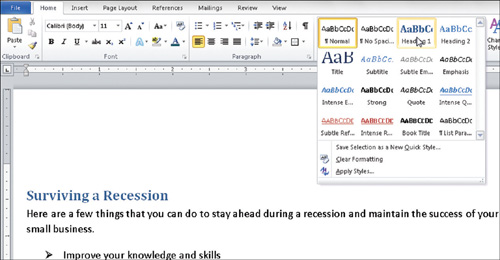You’ve already worked with direct formatting, which is where you
apply the formatting directly, such as bold, underline, or a different
font.
In the previous section, you
discovered themes. You discovered that themes change the overall colors,
fonts, and effects used in your document. However, there is a faster
way to quickly apply formatting: working with styles. Styles are a saved
collection of formatting steps. You can apply styles to characters,
paragraphs, lists, and tables.
Using Quick Styles
Quick Styles are predefined sets of font and
paragraph formatting settings, each designed to coordinate with each
other. For example, a Quick Style might include styles for headings,
titles, body text or even quotations. Some include color changes and
some do not. Quick Styles change how the different colors, fonts, and
effects are combined and which color, font, and effect is dominant.
Quick Styles are tied to themes and help maintain
design and consistency in your document without actually changing the
entire document theme. Use the following steps to work with Quick
Styles:
Select the text to which you want to apply formatting.
Choose
Home > Styles and click the More button next to the Styles scroll
bar. A gallery of style options appears, as shown in Figure 1.

As
you position your mouse over the styles, Live Preview shows you the
effect on your selected text. Select the option that best suits your
text.
Tip
Optionally, choose Home > Styles > Change
Styles > Style Set to view additional style options, which are named
after and originate from the different themes. (See Figure 2.)

Working in the Styles Task Pane
Every
new Word document includes styles; however, the exact styles the
document includes vary with the document template you use. The Quick Styles you worked with
in the previous section are the ones available with the standard blank
Word document.
Many companies have a complete series of styles they
use to standardize the look of company documents. In the next section,
you discover how to create your own styles. You can use the Styles task
pane for easy access to the standard and your custom styles.
From the Home tab, click the Styles group Dialog Box
Launcher. On the right side of your screen, the Styles task pane appears
like the one you see in Figure 3. The styles that have a paragraph mark (§) next to them are paragraph styles, and the ones that have an “a” next to them indicate they are character styles, and there are some that are marked with both. Word calls these linked
styles. Paragraph styles apply to entire paragraphs (such as alignment,
spacing, or tab settings), and character styles can apply to the text
itself (such as bold, italics, or font). Paragraph styles also include
everything that a character style contains. You mostly use paragraph and
character styles in your documents.

Linked
styles work as either a character style or a paragraph style, depending
on your selection. For example, if you simply click in a paragraph or
select a paragraph and then apply a linked style, Word applies the style
as a paragraph style. However, if you select specific words in the
paragraph and then apply a linked style, Word applies the style as a
character style with no effect on the overall paragraph. Word also has
table styles, which you apply to tables. From here you can click in or select your text and apply a style by clicking the desired style from the Styles task pane.
Tip
Click the Close button (x) when you are finished with the Styles task pane.